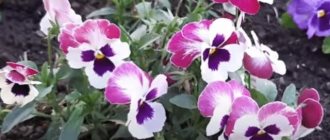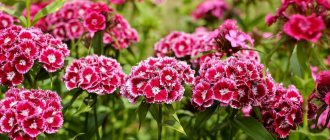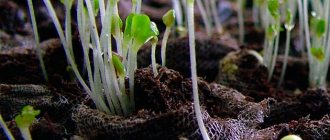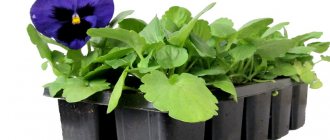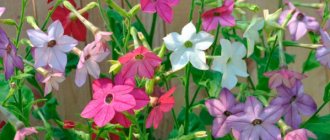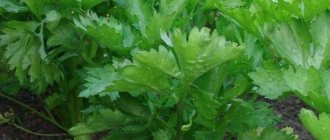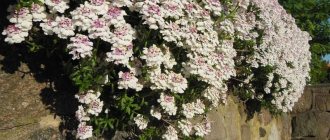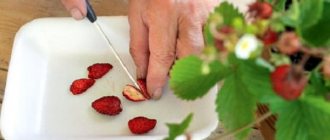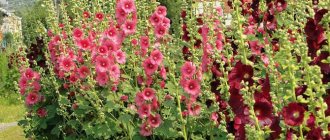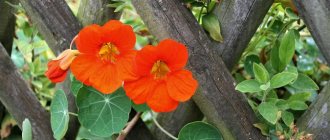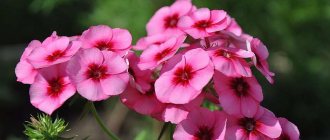Nasturtium is amazing not only for its beauty, but also for the fact that its flowers and leaves are edible and have a pleasant peppery taste. In Russia, the flower is grown as an annual plant. Flowering lasts from June until frost. Of course, the easiest way to grow a plant in your own area is to immediately sow the seeds in open ground. However, growing from seeds through seedlings is an interesting and exciting process that allows you to see at home all the stages of development of a young leaf.
Landing dates
Mature plants tolerate slight cooling. But young ones will not survive even light frosts, so sowing in the ground is possible only in May. At home, seedlings are sown in March - April.
The exact timing of when to plant nasturtium seedlings will be determined by the lunar calendar based on regional weather patterns.
According to the Lunar calendar
Favorable dates for sowing nasturtium depending on the phase of the moon:
- 2.3, March 28-31;
- April 1,2, 6,7, 24, 28, 29;
- May 3-6, 25, 26, 30;
- June 1-4.
At the end of May and beginning of June, the seeds are planted directly into the ground.
Sowing is not recommended:
- March 7-9, 20, 21, 24-26;
- April 3-5, 8, 16, 17, 21-23;
- 1,2, 7, 9, 10, 13-15, 18-20, 22 May;
- June 5, 6, 10, 11.
Garden work will not produce results during the full moon and new moon.
By region
Climatic spring occurs at different times in different regions.
- Southern regions - the optimal sowing time is early April;
- Middle zone and Central regions - mid-April;
- Siberia, the Urals and the Leningrad region - late April - May.
The timing of sowing seeds for seedlings varies from early April to mid-May
What varieties are grown by seedlings?
Perennial plants have good immunity and are resistant to external influences. They reproduce by self-sowing and grow on their own. Cultivated varieties need care and are grown through seedlings. Having gained beauty, they lost many of the properties of wild plants.
Shield-bearing
Nasturtium Lucifer, as the shield-bearing variety is also called, is an upright shrub with dark red flowers and an unusual shape of petals. With the seedling growing method, it blooms in early June and continues to bloom until the thermometer drops below zero.
Nasturtium shieldbearing
Small
Burgundy or red double large flowers on a short bush, less than 35 cm, are pleasing for a long time: from June to October. Plants planted in flowerpots will continue to bloom if placed at home.
Small nasturtium
Cultural
Hybrid varieties of this species are divided into:
- dwarf – up to 20 cm high;
- creeping - climbing stems 3-4 m long;
- compact - bush height 45-50 cm.
Varieties with red, golden-yellow, yellow-orange flowers, double and simple shapes are presented.
Nasturtium cultivated
Big
The branched, fragile stems of creeping varieties of Big nasturtium grow up to 2 meters. Erect - up to 75 cm. Long-lasting flowering, until the first frost. The seeds formed on the first flowers in June ripen and are suitable for sowing the next year. Their germination persists for up to four years.
The color range is extensive. The flowers have many shades of red, orange, and there are also variegated specimens.
Large nasturtium
Foreign or Canarian
Long shoots, up to 3.5 m, grow very quickly. This variety is excellent for creating hedges, decorative braiding of gazebos and fences.
It blooms from July to October with small yellow inflorescences. The flowers have ruffled petals and green spurs.
Foreign nasturtium
The seeds of this species do not have time to ripen.
How to collect nasturtium seeds correctly?
If you liked this crop and you want it to please you with its flowering next year, be sure to collect all the seeds that have ripened on the plant. It is much better to propagate nasturtium with your own seeds, rather than purchased ones.
- Nasturtium seeds ripen into peculiar fruits, and this process begins, as expected, after the flower withers.
- The seeds ripen for about 1.5 months, and after that, if they are not collected, they fall into the ground.
- So, to decide when exactly you need to collect the seeds, take a look at the fruits. The ripened fruit becomes white, yellowish, but not green. If the fruit has become the appropriate color, carefully pick it.
Nasturtium seeds
- Only the healthiest and largest seeds are selected for sowing.
- If you allow self-sowing, that is, you miss the moment when the seeds are ripe and they fall into the ground, then it is quite possible that they will lie there all winter, and in the spring, under suitable weather conditions, they will germinate.
Planting seeds for seedlings
The advantage of growing through seedlings:
- early flowering;
- germination guarantee;
- strong healthy seedlings.
Flower growers have invented a variety of methods for sowing seeds, each of which has its own advantages and gives excellent results.
Traditional way
This method is no different from sowing seeds of other annual flowers and has two options.
- The seeds are placed in a common container. When 3-4 true leaves appear, the seedlings dive into separate pots. The downside is the fragile stems and roots of nasturtium, which are easily damaged during transplantation.
- Sowing in individual containers. The soaked seeds are placed in cups, peat tablets, pots, buried 1-1.5 cm into the soil.
Nasturtium seeds are large and spreading them is not difficult.
In both cases, the container with planted flowers is covered with plastic film, a bag or glass and placed in a warm place with a temperature of 20-22 degrees.
Planting in sawdust
An unconventional method - germination in sawdust - is suitable for subsequent picking. In this case, the sprouts are easily removed and are not damaged.
Sawdust is placed in a container in a layer of 3-3.5 cm. Pour boiling water over it until completely moistened. Sawdust should not be allowed to float in the water; the substance should be loose. They should just be wet.
Make holes in hot sawdust at a distance of 4-6 cm and place dry grains in them. Pre-soaking them is not required with this method of planting.
Place bags over the container and place them in a warm place for germination. The seeds do not need light at this stage. The container is transferred to a sunny place after 5-6 days, when the first shoots appear.
When all the seeds have sprouted and 2-3 full leaves appear on the sprouts, they are transplanted into separate containers. The seedlings are quickly and without damage removed from the loose sawdust.
For the base, use sawdust from deciduous trees or compressed sawdust pellets for filling cat litter boxes. In conifers, due to the high resin content, the seeds will not germinate.
Growing nasturtium without soil
To be sure of the emergence of seedlings, the seeds are pre-germinated. No soil is required for this.
Cotton wool is spread into the container and watered with water with the addition of a growth stimulator. Seeds are placed on wet cotton wool at a distance of 2 cm from each other. Cover the top with another layer of cotton wool or cotton pads. The liquid should saturate both layers of cotton wool, since seeds require a lot of moisture to germinate.
After the first shoots appear, the seedlings are placed in separate cups. It is recommended to do this with tweezers, as the sprouts are very fragile.
A clean and replant-free way to grow seedlings is to sow them in peat tablets. Maintenance of the plantings in them is minimal, as only watering is required. All nutrients are already in the filler.
- Place the tablets in a tray.
- Pour warm water for 30 minutes.
- Drain excess liquid from the pan.
- Deepen the seeds 10-15 mm into the recess of the tablet.
- Cover with plastic.
Plant seedlings directly with the tablet. This is the most gentle way of growing.
Landing in the "snail"
A popular way to obtain seedlings is in “snails”. Rolls are made with earthen soil or replaced with paper napkins or toilet paper.
To do this you will need:
- strip of dense polyethylene or backing for laminate size: 10 cm x 100 cm;
- toilet paper or napkins. Their quantity should be enough for 2 layers along the entire length of the film strip;
- 2-3 rubber bands for banknotes, rope or tape;
- round container.
Roll making process:
- Unfold the plastic on the table.
- Place paper over it.
- Dilute 3 drops of Epin in 1 liter of water and moisten the napkins.
- Spread dry seeds 4-5 cm apart, 15 mm from the edge. This will be the top edge.
- At the end, leave 10-15 cm without seeds.
- Roll the tape into a tight roll, making sure that the seeds do not move.
- Secure the film with tape, rubber bands or twine.
- Place the “snail” in a container with pre-filled warm water.
- Cover the top with a bag to create a greenhouse effect.
To make a roll of soil, soil is laid out instead of paper. All other actions are the same.
After green sprouts appear, the bag is removed and the bucket with the roll is placed in a bright place.
When 2-3 leaves grow on the seedlings, picking is necessary. To do this, the “snail” is placed on the table and carefully unfolded. The seedlings do not have to be pulled out or divided. All roots remain intact and easily take root in a new place.
How to store nasturtium seeds?
In order to sow nasturtium again in the spring, it is necessary to properly store the seeds collected in the fall:
- Once all the seeds have been collected, they need to be re-examined. Next, you should select the best ones from those available, and throw away all the small and sick ones.
- Then you should dry the seeds a little on the windowsill and package them.
- Seed material should be stored in paper bags in a dry place. At the same time, the temperature in the room where the seeds will be stored must be maintained at least 20°C.
Nasturtium is a beautiful flower that is completely unpretentious compared to other crops. This plant gets along well with almost any “neighbors”, its combination with which creates a beautiful view in the garden.
Home growing technology
In addition to the growing conditions, the quality of seedlings is affected by the preparatory stage of sowing.
Seed selection and preparation
For planting, choose full-bodied grains without damage or stains. Since the seeds are large, choosing quality ones is not difficult.
Nasturtium seeds To speed up germination, pre-sowing preparation is carried out - the seed material is soaked in a solution of any growth stimulant: Zircon, Epin or honey, ash, aloe juice. A solution of a store-bought drug is prepared in accordance with the instructions.
Home remedies are dissolved in the following proportions:
- aloe juice and water 1:1, soaking time 24 hours;
- 1 teaspoon of honey per glass of water, soak for 6 hours;
- Dilute 1 tablespoon of wood ash in 250 ml of water and leave for 48 hours. Place the seeds in this solution for 6 hours.
This stage is effective, but not mandatory.
Soil selection and preparation
Nasturtium seedlings grow and develop best in loose, light soil with neutral acidity. The store buys ready-made soil for these plants. When purchasing “Universal” soil, you will have to add coarse sand, vermiculite or perlite to it to improve the structure and increase air and water permeability.
Homemade soil mixture is prepared from equal parts of river sand, peat and turf soil
Selection of capacity
For seedlings, the volume of the container is important - 200-250 ml. it feels equally good in plastic, metal and other cups.
The best option is peat pots, from which you do not need to remove seedlings when planting on the site.
Direct sowing
Planting seeds is easy:
- pour a 15 mm drainage layer into the container;
- lay the soil, not reaching the top 20-25 mm;
- moisten the soil generously;
- make a 15-20 mm depression in the center;
- put a seed;
- fill with soil until the depression is leveled with the general surface;
- cover the top to create a mini-greenhouse;
- put in a warm place.
Agrotechnical requirements for cultivation
Many experienced gardeners know about the capuchin's unpretentiousness to growing conditions. But despite this, if the goal is to obtain lush flowering, then you need to take care to comply with several simple requirements.
The soil
The best option for growing a representative of nasturtium will be light and moderately fertile soils with a high-quality drainage system. The decision to grow a capuchin in an area rich in organic matter will not achieve the goal of vigorous flowering. This is primarily due to the fact that in such a situation the plant, due to the abundance of organic fertilizers, will form only excellent shoots.
Choosing a location with mostly infertile soils will also not be a good decision. In poor soil conditions, the stems will be bare for almost the entire season, forming only small leaves. And an attempt to grow a crop on heavy soil will not be successful: it will be affected by various diseases, which often leads to its complete death.
Lighting and windiness
Taking into account that nasturtium is a heat- and light-loving crop, optimal conditions for its growth can only be created in areas where access to sunlight is open. Planting capuchin in a semi-shaded location will produce nothing but strong stems and dense green foliage throughout the season. When choosing a location, you should also take into account that drafts harm it. Therefore, the area where this flower will grow must be windless.
Specifics of care during the period of growing seedlings
In the first days after planting, before the first shoots appear, the container must be regularly ventilated and condensation removed. If the top layer of soil has dried out, moisten it with a sprinkler or a medical syringe.
Temperature, lighting and humidity
Hatching sprouts immediately require light. They are transferred to the most illuminated place, where the photoperiod lasts at least 14-16 hours. If necessary, install additional lighting. With a lack of lighting, seedlings stretch out and their development freezes.
The plant is heat-loving; growth slows down at temperatures below +18. But heat above +22 degrees is not good either
Nasturtium prefers dry air.
Watering and fertilizing
The need for watering is indicated by the dried top layer of soil. Usually watering is combined with fertilizing. The first for seedlings is carried out with complex mineral fertilizers with a mandatory nitrogen content.
A few days before picking, use a potassium-containing solution
Rules for picking Nasturtium
Nasturtium does not tolerate picking well. Its root system is weak, so when growing, gentle methods are recommended: growing in sawdust rolls or directly in separate pots.
The soil is taken the same in which the plant grew before picking. The hole is made deep and wide so that the sprout can be removed into it before the first leaves begin to appear.
Cover carefully with light, dry soil, being careful not to damage the fragile roots and stems. Water after planting.
Disease and pest control
The maintenance of nasturtium involves carrying out preventive measures in the fight against infections and parasites. There is nothing complicated; even a gardener without experience can do it. The culture is endowed with a specific smell that repels many harmful insects. Sometimes a plant can suffer from cabbage whites, leafminer flies, aphids, and spider mites. Systemic insecticides will help neutralize harmful insects.
If you do not properly care for a crop, it can also be affected by diseases:
- gray rot, in which dry brown spots form on the foliage;
- bacterial wilt, which at the initial stage is manifested by yellowing of the lower leaves, and then withering of the entire bush;
- rust, which is diagnosed by black and brown spots on the leaf blades.
Treatment consists of destroying the infected parts of the plant and treating them with chemical and bacteriological preparations.
It’s impossible not to love nasturtium. It exudes positivity, it is especially good during the flowering period. Knowing how to plant nasturtium, you can transform your garden plot beyond recognition. Bright and bewitching flowers will cause a lot of admiring glances and pleasant compliments.
Transplantation into open ground
Nasturtium seedlings are planted in a permanent place after the onset of warm weather. The slightest cold snap will destroy it. Seedlings with a height of at least 7 cm are considered ready for outdoor use.
Site preparation
The best place is sunny, protected from drafts. The soil should be fertile, loose and light.
If these conditions are met, the plant will delight you with lush greenery and bright flowers.
Seedling diagram
Nasturtiums require a lot of space. The distance between neighboring plants should be at least 20 cm, and if the variety is shrubby, then the distance is increased to 40 cm.
The holes are made in advance. Their depth and width depend on the volume of the container in which the seedlings grow. They try to plant with a clod of earth. And when growing in peat pots, the bottom is torn and placed in the hole directly with the pot.
Description of culture
Nasturtium, or capuchin, is a representative of the genus of herbaceous plants, which has more than 90 species. The plant belongs to the Nasturtium family, and its homeland is considered to be South and Central America. But despite this, it has been growing in temperate latitudes for a long time, feeling excellent.
Nasturtium was brought to Europe from India, so residents of European countries called it “Indian watercress.” When the flower was brought to Russia from Holland, it became the owner of the name “capuchin”. The reason for this name was its shape, which resembled the hood of the Capuchin monks. Nowadays, a culture filled with grace can very often be found in park areas, front gardens and even on window sills.
Further care
The acclimatization period lasts two weeks. At this time, the plant requires special attention and care.
Watering
You should be careful with watering. If a slight drought of an adult nasturtium does not harm, then with an excess of liquid at any age, root rot begins to develop.
Young plants, especially during the rooting period, need abundant watering. It is cut back during flowering.
Fertilizer
After placement on the site, the soil around the nasturtium is sprinkled with mulch. Before the flowers bloom, they are fed once a week with phosphorus-potassium complex fertilizers. It is not recommended to give nitrogen-containing fertilizer. This will lead to the growth of green mass to the detriment of flowering.
Phosphorus-potassium fertilizers
Trimming
The procedure will help maintain a beautiful appearance and sanitation. Pruning includes the removal of faded and weak peduncles and parts of the flower that show signs of disease.
When plantings become thicker, it is permissible to trim off excess foliage. This stimulates the formation of additional buds.
Propagation by cuttings
Adonis flower - planting and care in open ground
You can acquire nasturtium by using the method of propagation by cuttings, which preserves all the varietal and species characteristics of the mother plant.
To do this, cut off mature, well-grown shoots with 3-4 leaves. It is recommended to treat the lower cut with a growth stimulator.
Root cuttings in wet sand or water. Once the roots are formed, they must be transplanted into prepared soil in containers or in a flower bed. It is important to be careful not to damage the root system when planting.
Terry nasturtium is bred in this way; it is also recommended for very rare varieties, the seeds of which are difficult to buy.
